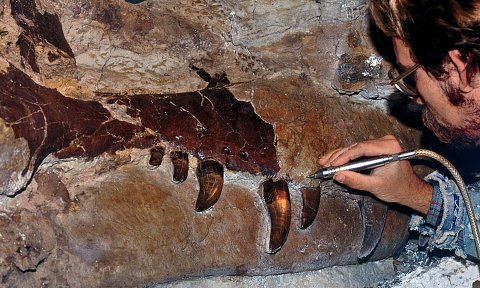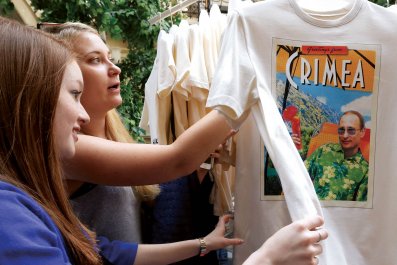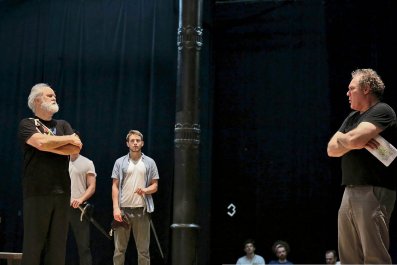Peter Larson laughs a lot—a loud chortle that could cheer up a blobfish. He's laughing now about an "intercostal clavicle," the brontosaurus bone Cary Grant searched for in Bringing Up Baby—a 1938 screwball comedy about a bemused paleontologist, a flighty socialite (Katharine Hepburn) and her pet leopard, Baby. The intercostal clavicle, Larson explains, is something of a paleontological joke. "There's no such bone!" he says. Not that dinosaurs lacked for clavicles. "The clavicle part is real. In birds, the fused clavicles form the furcula, or wishbone. And nowadays—in 2014—we know that dinosaurs had wishbones, too."
Larson should know. He was the paleontologist who discovered the furcula of a Tyrannosaurus rex. He was also the first to find a way to differentiate female from male dinos by the size of their tailbones. And the first—and so far only—paleontologist to be jailed after digging up Cretaceous Period fossils. He's still making important discoveries, and his contentious past is now the subject of Dinosaur 13, an earnest, agenda-driven documentary that's less a sequel to The Land Before Time than a kind of Law & Order: B.C. With a Tea Party–like brio, the film lambastes Uncle Sam's aggressive prosecution of working Joes. "There are increasing incursions by government officials into our personal private lives," Larson says. "People need to know where that may lead."
The film's agenda is to vindicate the 62-year-old Larson and four fellow commercial collectors at the Black Hills Institute of Geological Research in South Dakota. Two decades ago, a federal grand jury indicted them on scores of counts, most of which related to trafficking in fossils illegally excavated from federal land. Though many of the charges were later dismissed, Larson was convicted of two felonies (both customs violations) and two misdemeanors, and sentenced to two years in federal prison. That part of his life played out like an old Sonny Curtis and the Crickets song.
"Breakin' rocks in the hot sun,
I fought the law and the law won."
On this 21st century afternoon, Larson sips Brooklyn Lager in the café of a Manhattan hotel while talking lizards and lockup. "Paleontologists love beer," he says. Like his Bringing Up Baby counterpart, he's bespectacled, absent-minded and romantically challenged (four marriages, four divorces). He comes across as a slightly naive, fossil-fancying nerd in Dinosaur 13, and his telling of the facts is as one-sided as a defendant's brief. In the hands of director Todd Douglas Miller, a complex legal tar pit of ownership rights becomes a smackdown between prospecting patriots and a tag team of shifty Native Americans and petty, overstepping federal agents. The prospectors get to tell their story; the Native Americans don't.
Larson says the spokesman for the tribe declined to be interviewed by the filmmaker—which is not to say the tribe has no opinion. Asked about the traditional stance toward digging for dinosaur bones, Steven Vance, the tribal historic preservation officer for the Cheyenne River Sioux, has said: "We never dug them; if we knew where they were, we left them. When it comes to making money on them, as traditional people we frown on it." Larson the collector makes no bones about hunting fossils for the loot.
As the film recounts, Larson grew up on a ranch outside Mission, South Dakota, in the heart of the Rosebud Indian reservation. During his youth, he and his brother Neal dug up enough bones to fill a Jurassic parking lot. ("The Flintstones wasn't accurate!" he says, wistfully. What's his objection? "Dinosaurs living at the same time as humans!") The Larson boys opened a fossil and minerals shop in Hill City that, in 1974, became the Black Hills Institute. Initially, Larson's prized finds tended to be duckbill dinosaurs.
The institute hit pay dirt in 1990 when crew member Sue Hendrickson stumbled upon some skeletal remains on a Cheyenne River Reservation ranch. She brought bone fragments to Larson, who recognized their honeycombed structure immediately as little bits of T. rex. He dashed to the site and beheld the protruding skeleton of a 65 million-year-old female. She was 42 feet long and 13 feet high (at her hips)—making her, at the time, the largest and most complete specimen to be excavated. Named after her discoverer, "Sue" was only the 13th T. rex ever excavated, which is how Dinosaur 13 got its name.
Larson paid $5,000 to the landowner, a Sioux named Maurice Williams, for the rights to remove Sue and, he thought, purchase her. (Though the figure was then the highest on record for a Tyrannosaurus, dinosaur fossils more common than the T. rex had reportedly brought as much as $350,000––a fact omitted from the documentary.) Following the excavation, Sue was moved about 140 miles, to Hill City, where the institute planned to build a nonprofit museum that would display her and other fossils. Larson invited academic and government paleontologists to take part in a broad study of what he called the "Tyrant Lizard Queen."
Larson says she probably bit the Mesozoic dust in T. rex–on–T. rex combat. A tooth from another Tyrannosaurus was embedded in her neck, two tailbones were smashed, and the back of the left side of her lower jaw was yanked out and rotated. "If you think Sue's big," says Larson, "just imagine the T. rex that killed her!" A couple of youngsters also may have died in the fight. Larson found the partial remains of a baby and a teenager nearby.
During the spring of 1992, while Larson's team prepared Sue, the FBI raided the Black Hills Institute and—backed up by the National Guard—seized many of its fossils. As outraged residents of Hill City staged "Free Sue" protests, Sue was packed up and carted off to a storeroom in Rapid City, 25 miles away. The United States attorney for South Dakota said he had acted on complaints from leaders of the Cheyenne River Sioux tribe, who had urged an investigation of possible wrongdoing by the institute. The dinosaur was found on Williams's land, which had been placed in trust to the Department of the Interior in lieu of property taxes. In court, he contended the $5,000 was a payment for having disturbed the land, not for Sue.

"I lost my girl and I lost my fun,
I fought the law and the law won."
Not long after that, Larson and several of his Black Hills colleagues were named in a 153-charge, 39-count federal indictment. The charges, ranging from theft and money laundering to conspiracy, were unrelated to Sue. In Dinosaur 13, Larson laments: "If you add up the time served for each of those counts, it comes to 353 years for me—which is longer than Jeffrey Dahmer was sentenced to prison for, and he killed and ate, like, 15 people!"
Convicted of four of the charges, Larson served 18 months of his sentence at the same Florence, Colorado, lockdown that housed John Gotti, Theodore Kaczynski and Timothy McVeigh. Meanwhile, a federal court ruled that Sue belonged to Williams, who in 1997 sold her to an unlikely consortium composed of the Disney Corp., McDonald's and the Field Museum of Natural History in Chicago, where she's now on permanent exhibit. At auction, Sue fetched an astonishing $8.36 million.
Larson stayed busy behind bars. He taught classes on paleontology and life on Mars, which he thinks is possible. The favorite class he audited? "'How to Make Money.' The lecturer was a convicted counterfeiter."
"I left my baby and it feels so bad,
Guess my race is run…"
Were there any upsides for Larson? "Lots," he says. "We got about $20 million worth of advertising, and it only cost us a million in legal fees—and my sabbatical with Uncle Sam, of course. The sale of Sue has also established the fact that fossils, and the science of paleontology for that matter, have real and quantifiable value. Those values will help businesses like ours, ranches and paleontologists survive into the future. All of the publicity involved with Sue also helps people understand how much we can learn from fossils if they are properly collected, prepared and studied."
These days, Larson and his colleagues dig in a mean stretch of Badlands called Hell Creek. In all, they have dug up eight mountable dinosaurs. "There's Dan, Duffy, Wyrex, E.D. Cope, Bucky, Foxy Lady, the new one that hasn't been given an official name yet and.... I can't remember the last one." It's Stan. His mold was cast with clay and Legos. Larson has also helped name two dinosaur species: the Tatonka Ceratops and the Draco-Rex Hogwartsia. (He's a big Harry Potter fan.)
Oh, about those T. rex wishbones. Larson says they reveal a lot about the Tyrant Lizard's arms. For eons, their puny arms have baffled scientists. The wishbone showed how closely the dinosaurs were related to birds, how they moved and how they used their hands. Larson says Sue was a quick-moving hunter whose long tail counterbalanced the up-front weight of her enormous head. "She was probably a great dancer," he says. "Not ballroom dancing—more like modern dance. But she couldn't tango. She didn't have the arms."
"... She's the best girl that I ever had,
I fought the law and the law won."





























